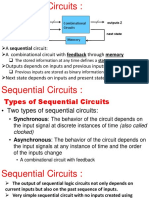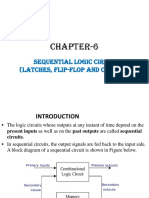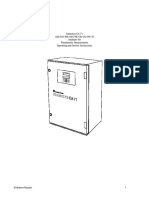0% found this document useful (0 votes)
12 views5 pagesSequential Circuits
Sequential circuits are defined by their outputs depending on both present inputs and previous states, incorporating memory elements and requiring clock signals. They can be categorized into synchronous and asynchronous types, with various triggering methods such as level and edge triggering. Key components include latches and flip-flops, each with distinct operational characteristics and state tables.
Uploaded by
churij5639Copyright
© © All Rights Reserved
We take content rights seriously. If you suspect this is your content, claim it here.
Available Formats
Download as PDF, TXT or read online on Scribd
0% found this document useful (0 votes)
12 views5 pagesSequential Circuits
Sequential circuits are defined by their outputs depending on both present inputs and previous states, incorporating memory elements and requiring clock signals. They can be categorized into synchronous and asynchronous types, with various triggering methods such as level and edge triggering. Key components include latches and flip-flops, each with distinct operational characteristics and state tables.
Uploaded by
churij5639Copyright
© © All Rights Reserved
We take content rights seriously. If you suspect this is your content, claim it here.
Available Formats
Download as PDF, TXT or read online on Scribd
/ 5






















































































